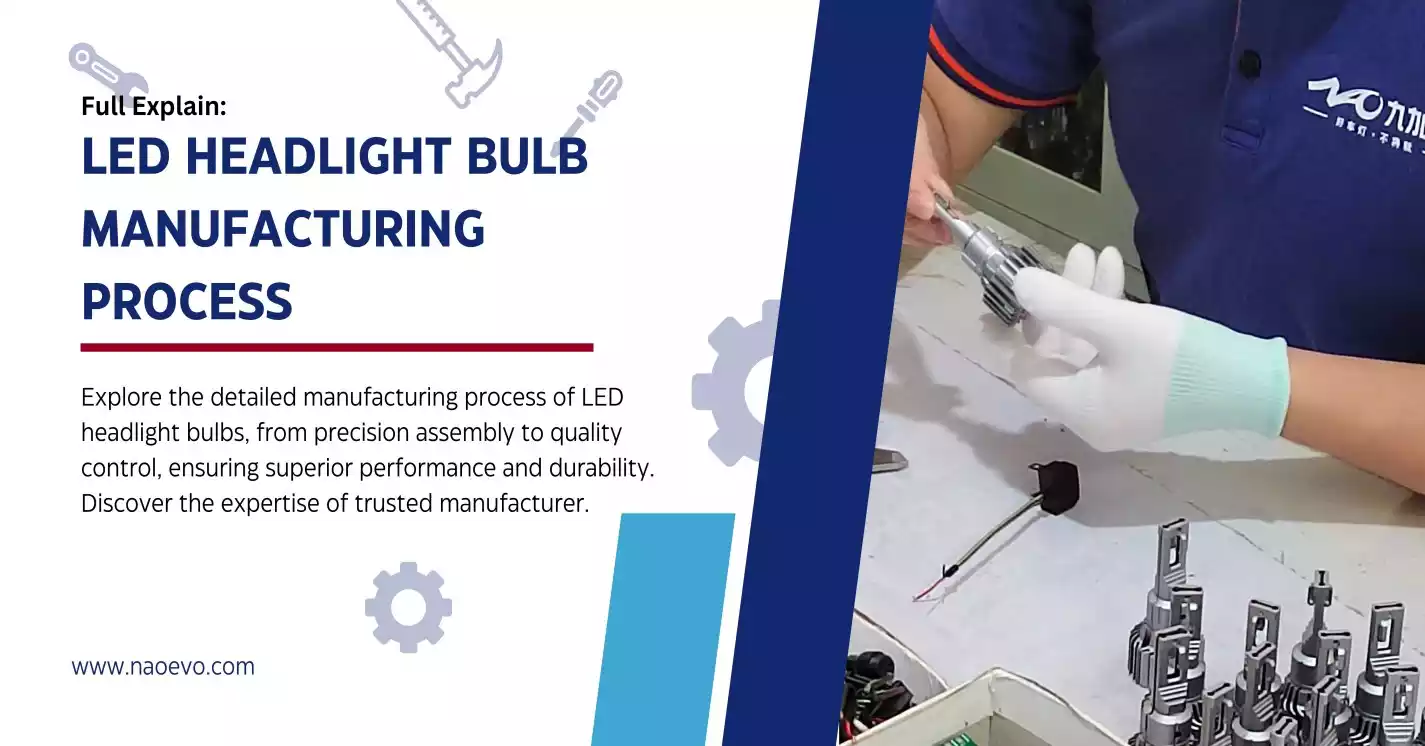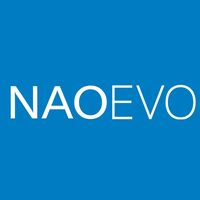Quality LED bulbs from reputable manufacturers are essential for brand building and business growth in the auto lighting market. A reliable headlight bulb manufacturer not only offers high-end products but also provides exceptional after-sales service and exclusive benefits for their distributors.
While product quality is a crucial consideration when choosing a headlight bulb supplier, it can be challenging to determine quality solely by purchasing a sample or relying on online customer reviews, which may not reflect the true product situation.
However, in this blog, we present the manufacturing process of premium LED headlight bulbs from NAOEVO, a professional automotive lighting manufacturer based in China. This comprehensive overview allows wholesalers, distributors, retailers to gain a thorough understanding of their product quality before purchasing in bulk.
The Main Components of LED Headlight Bulb
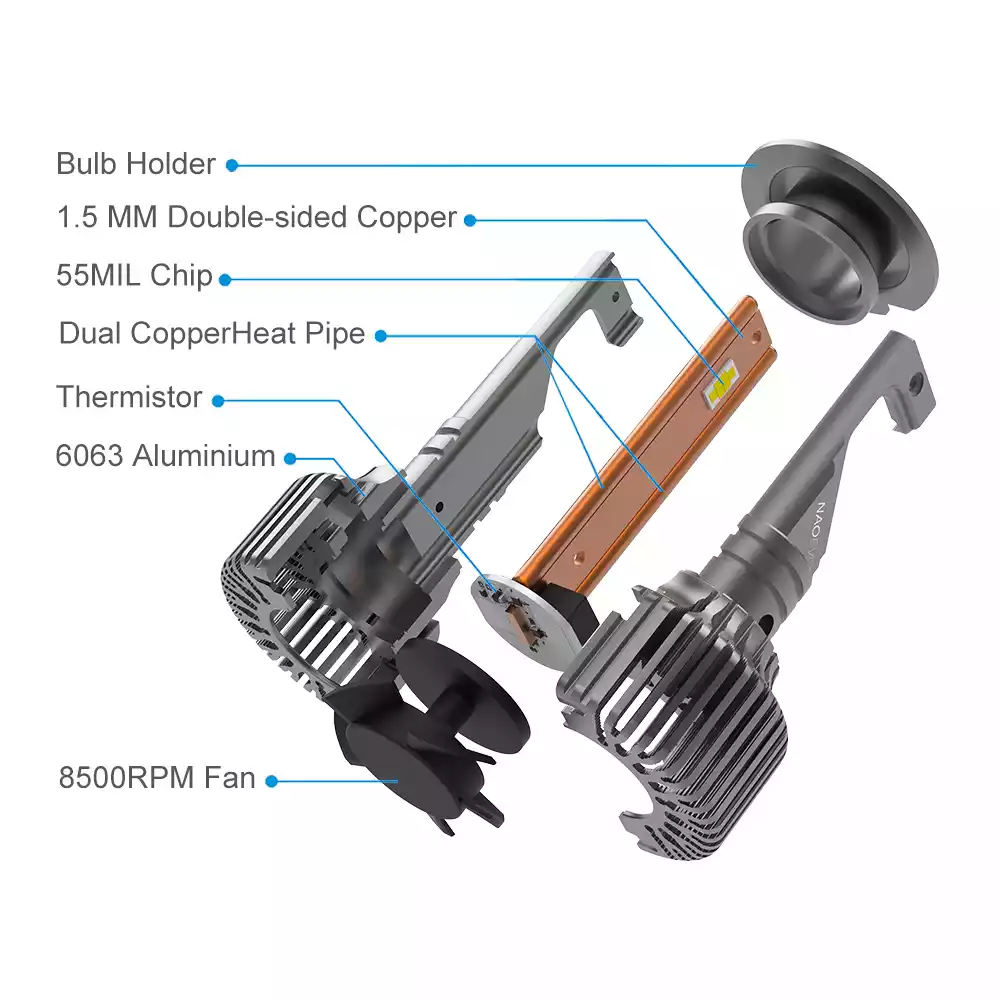
The main components of an LED headlight bulb encompass the LED chip, lamp body, circuit board, and fan.
The LED chip serves as the light source, providing bright and efficient illumination. The lamp body mostly is made of 6063 aluminum to protect the components while ensuring proper heat dissipation. The circuit board controls the electrical current and voltage, ensuring stable performance. The fan aids in cooling the bulb, preventing overheating and prolonging its lifespan.
Together, these components create a reliable and durable LED headlight bulb that delivers enhanced visibility, energy efficiency, and longevity for a safer and more efficient lighting solution in automotive applications.
The Manufacturing Process of Quality LED Headlight Bulbs
1. Research, Development and Design
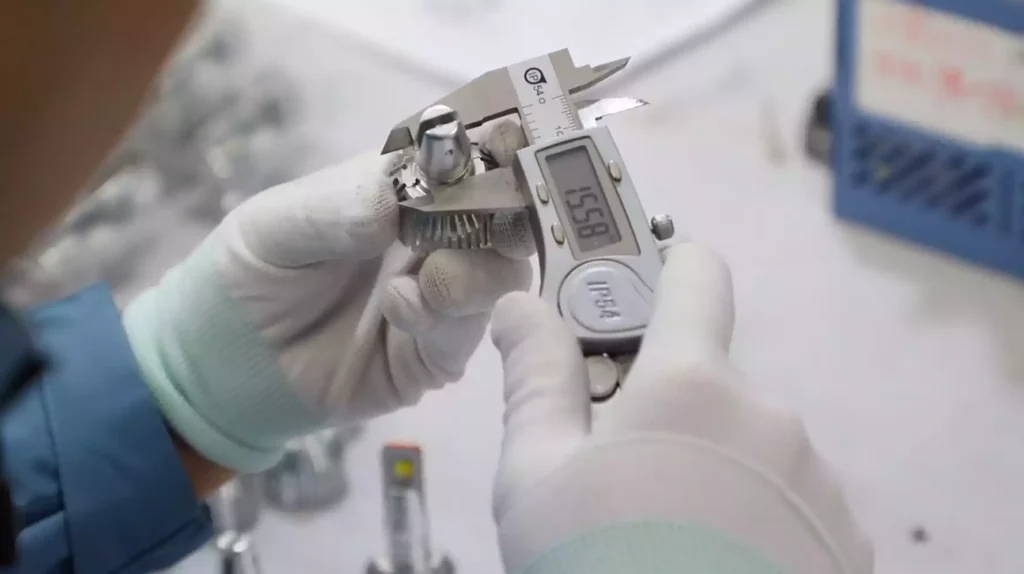
With today’s innovation, there is more creativity allowed in researching and developing LED headlight bulbs. Before manufacturing takes place, we will do an in-depth market research for our new products to understand the market trends, customer needs, and technological advancements.
If the LED bulbs meet the requirements of consumers. We will come in designing, testing and producing. If they don’t pass the test, we will send them back to re-design, re-develop and re-testing. We need to ensure the bulbs have a high performance in every aspect before we start mass production.
Testing Equipment Involved
1. Integrating Sphere:
An integrating sphere ensures accurate measurement of optical parameters such as luminous flux and color rendering index for LED headlight bulbs by uniformly distributing light.
2. Spectrometers:
Used to analyze the spectral output of the LED headlight bulb, measuring the light emitted within specific wavelengths and ensuring it falls within the desired range.
3. Light Beam Pattern Test System:
We have a dark room with 180 degrees of measurable space. The light spread and the lux on the wall can be clearly seen so that we can make a further improvement for the bulbs.
4. Thermal Testing Equipment:
Includes thermal chambers and thermal imaging cameras to assess the heat dissipation capabilities of the LED headlight bulb, ensuring it can effectively manage heat generated during operation.
5. Vibration and Shock Testers:
Used to simulate road conditions and test the durability and reliability of the LED headlight bulb, ensuring it can withstand vibrations and shocks without affecting performance.
2. SMT Machine
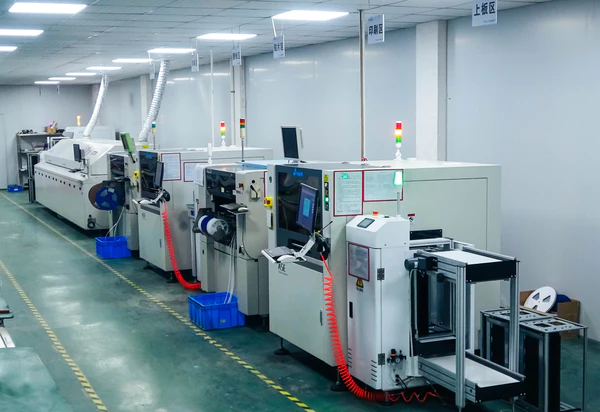
After we have designed and developed our products, we will begin the procurement of raw materials and conduct inspection. This includes assessing the quality of the LED chips, aluminum, drivers, fans wiring, and other critical elements.
After ensuring that the raw materials meet the quality standards, we use the SMT machine for the precise placement and soldering of surface mount components, especially in placing LED chips on the base board. SMT machines enable high-speed and accurate assembly, ensuring the proper functioning of the LED headlight bulbs.
3. Light Source Inspection
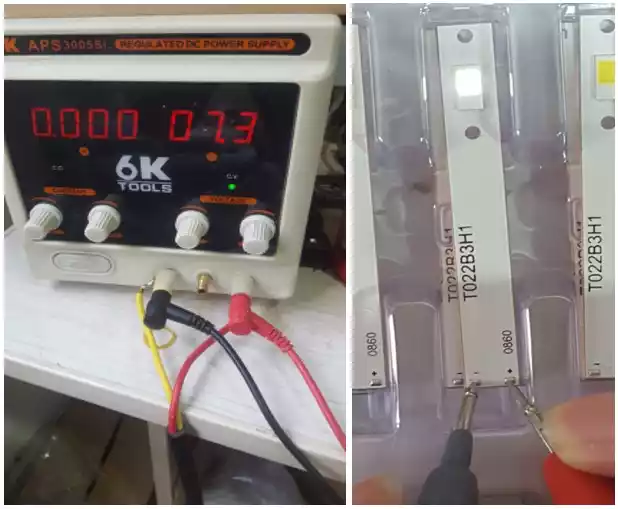
(We test and check the LED chips with Regulated DC Power Supply to ensure the output remains constant even if the input changes)
Detecting the light source is the first step in LED headlight production. In the beginning, a thorough detection will take on the appearance of the substrate and the chips to check whether they are damaged or scratched or not.
Then, we will use the regulated DC power supply device to test the light source of the bulbs. First, set the power supply to the desired voltage and current specifications. Connect the positive and negative terminals of the power supply to the corresponding terminals on the LED bulb. Gradually increase the voltage while observing its brightness, color accuracy, and stability, ensuring they meet the required standards.
Connect the positive and negative poles of the substrate, and put it under the light filter to test whether the LED chips are working properly and the brightness is consistent. Light source detection in the brightness of LED car light bulbs, bringing them to standard in high-volume production for quality assurance.
4. Apply Thermal Grease
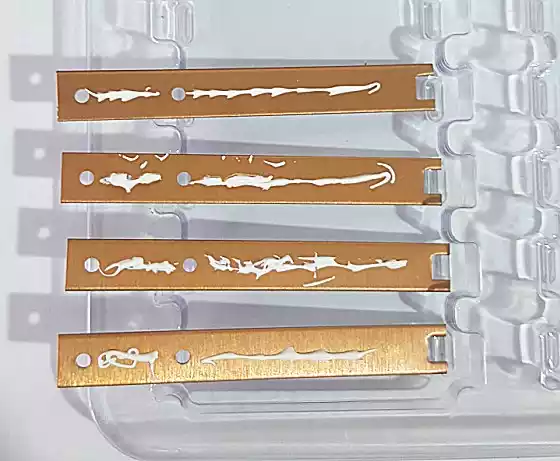
(We apply silicone grease on the copper substrate for stable quality)
Silicone grease consists of silicone oil combined with inert fillers that are thickened using a lithium soap. These greases exhibit exceptional properties such as water resistance, resistance to solvents, and protection against corrosion.
In this step, we will evenly spread the silicone grease over the entire light source positioning slot, ensuring that more than 80% of the area is coated with the grease. This can attach to the aluminum body tightly and firmly.
5. Mount The Light Source
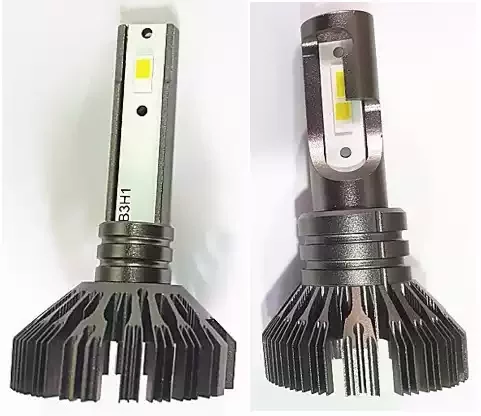
Upon completing the above two steps, we obtain the fundamental component of the LED bulb. Subsequently, we proceed to install the LED light source into the aluminum part.
Our QR team meticulously selects the finest aluminum material and adheres to stringent production procedures during each assembly step. We prioritize quality as customer satisfaction continues to propel us forward.
6. Riveting
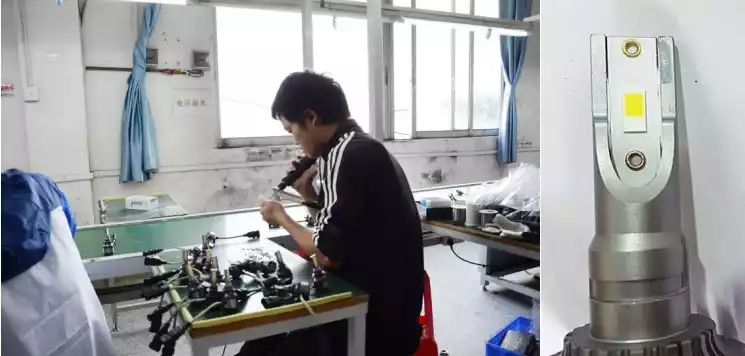
In this stage, our professional technicians install the rivets with rivet guns on the headlamp. Through fixing the rivets, they create a durable and reliable connection that ensures the stability and structural integrity of the LED headlight bulb. We take care of every move to protect the LED chips from scratch. With the help of rivets and silicone grease, our bulbs can highly resist vibration, water and high temperature.
7. Automatic Soldering Machine
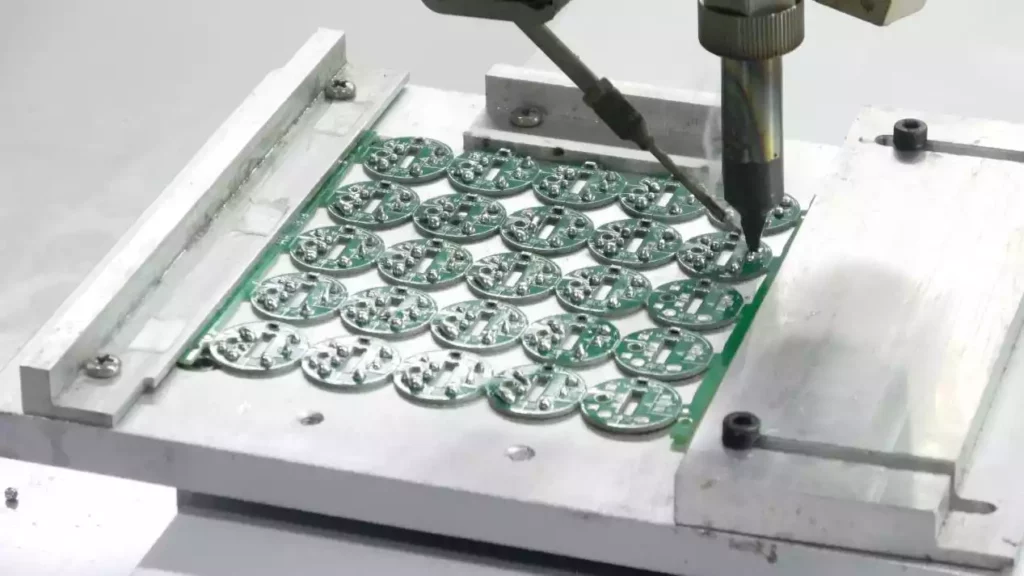
The driver plays an important role in LED headlight bulbs. Quality drivers make the LED light bulbs illuminate better. NAOEVO company adopts automatic production machines to meet the demands of mass production.
This automatic soldering machine uses the robot’s movement function to achieve the soldering process by melting the tin, which can reach the result of rapidity and stability. By using this machine, some electronic parts in the driver can be attached by soldering which is more solid and more reliable than artificial tin-coating. In this case, the poor quality of LED headlight bulbs caused by false welding has been greatly avoided.
8. Install The Driver Board
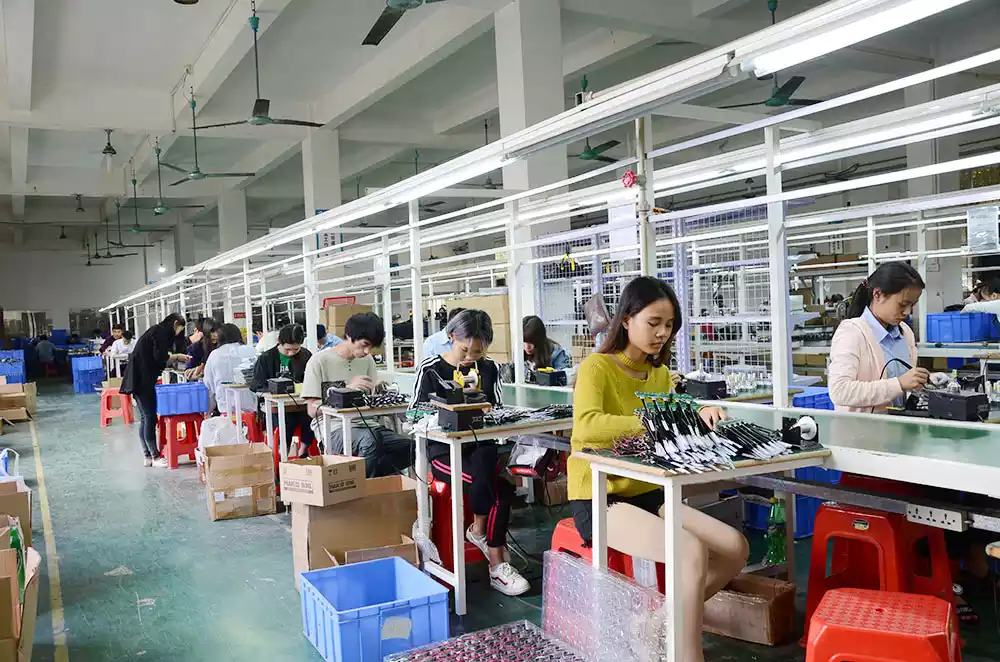
When the driver boards are finished by the soldering machine. We will manually attaching the board within the bulb assembly. The driver board, responsible for regulating the power supply and controlling the current to the LED chips, is aligned and connected to the appropriate terminals or connectors. This step ensures proper electrical connectivity and enables the driver board to effectively power the LED headlight bulb, resulting in reliable and efficient illumination.
9. Solder The Power Supply Wires

The manufacturing process of soldering the power supply wires of an LED headlight bulb involves carefully positioning the wires and terminals. Using soldering techniques, heat is applied to melt solder, which is then used to create a strong and reliable bond between the wires and terminals. This ensures a secure electrical connection, allowing the power supply to efficiently deliver the necessary current to the LED headlight bulb for proper operation and illumination. Attention to detail and precision are essential to ensure a high-quality soldering joint.
10. Solder The Fan
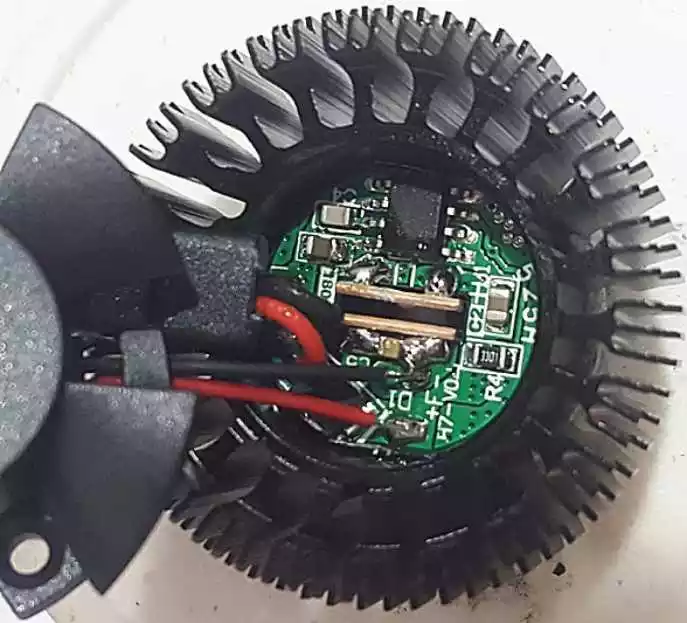
The fan inside the bulb plays an important role in product quality. A good fan is contributed to an efficient cooling so that the LED light bulbs can stay longer. In this stage, wiring of the fan will be carefully connected to the driver board, ensuring proper electrical and mechanical integration. Installing fan enables efficient heat dissipation, maintaining optimal operating temperatures and ensuring the longevity and performance of the LED headlight bulb.
11. LED Headlight Bulb Inspection
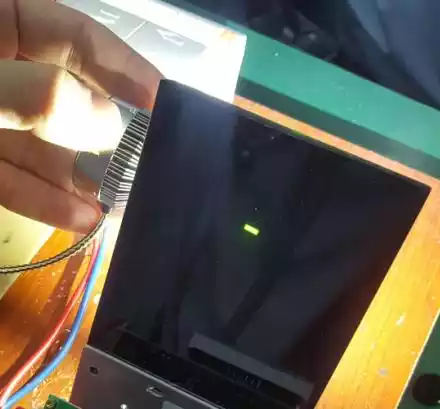
In this step, the major parts of the LED car light bulbs have been assembled. Before they enter into the next process, all the LED headlight bulbs would be tested to see if the LED chips are able to emit light normally, and whether the fan can operate quickly. If there’s a mistake in LED light bulb, we will send it back and test all the components from inside to outside. “ZERO” defect is our persistent pursuit of the goal!
12. Automatic Glue Dispensing Machine
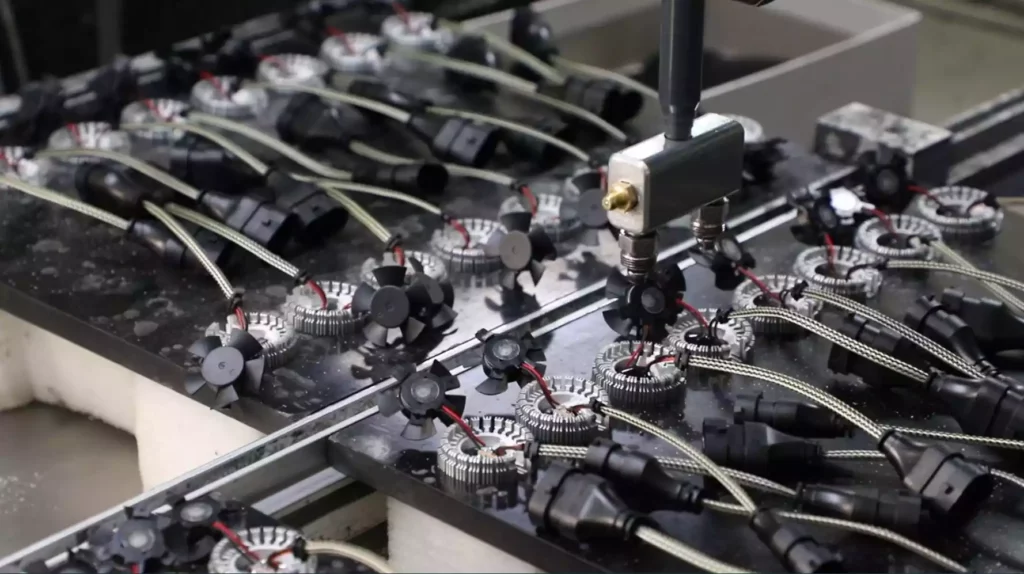
After ensuring that all the components of LED headlight bulb can work normally, we will use the Automatic Glue Dispensing Machine to inject the glue into driver board to join the wiring firmly. In this process, the glue applied to the driver is good for water-resistant, making the bulbs work stably and have better dissipation.
The automatic glue dispensing machine drips and applies fluid to the product to achieve accurate positioning, making no drawing, no leaking, no dripping. Thus, better quality than manual operation.
13. Fan Installation
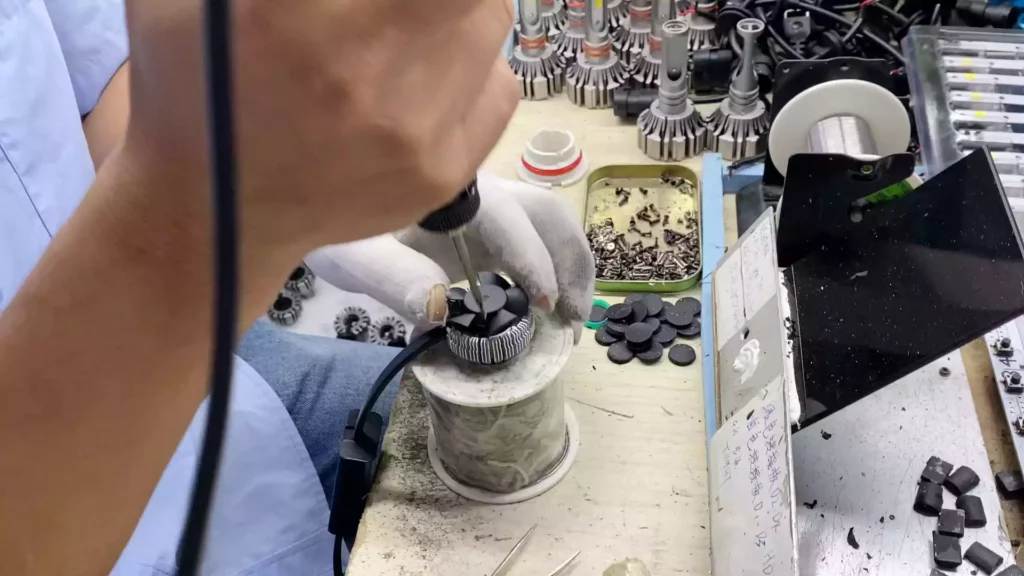
The fan, usually a compact unit, is carefully positioned within the housing, ensuring proper alignment with the heat sink. The fan is securely fastened in place using screws or clips. The wiring of the fan is then connected to the appropriate power source within the bulb assembly.
14. Aging Testing
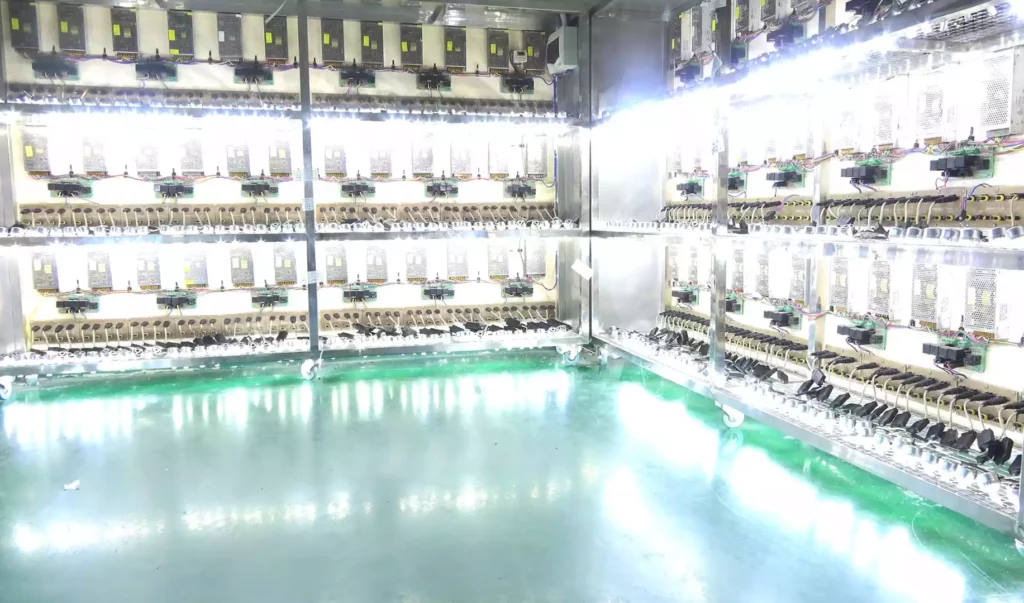
Aging testing plays a vital role in ensuring high-quality and reducing the failure rate of LED headlight bulb products. During this stage, each product undergoes a rigorous 72-hour testing period without any interruptions. This ensures that the LED headlamp functions properly and can be used reliably.
15. Clean The Bulb
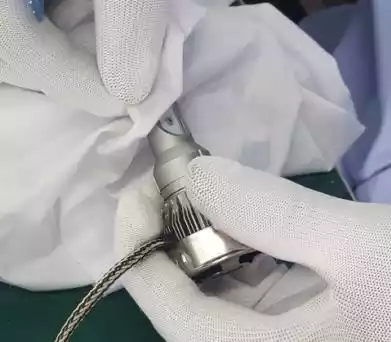
The process of cleaning LED headlight bulbs involves gently wiping the bulb surface with a soft, lint-free cloth. Care must be taken to avoid scratching or damaging the bulb.
16. Installing The Holder
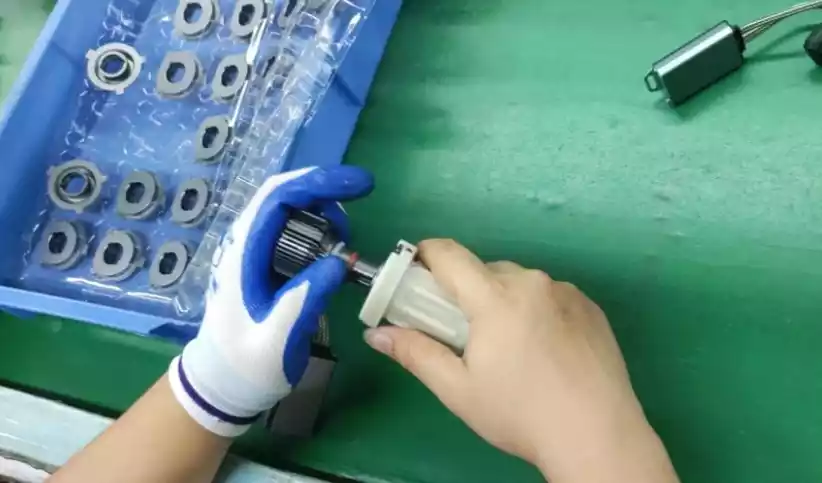
After cleaning the headlight bulbs, we will install the original design chuck with a sealing ring into the bulb, we ensure the chuck is as standard as the stock headlight bulb and make it easier to install in the headlight housing.
17. Make Laser Logo
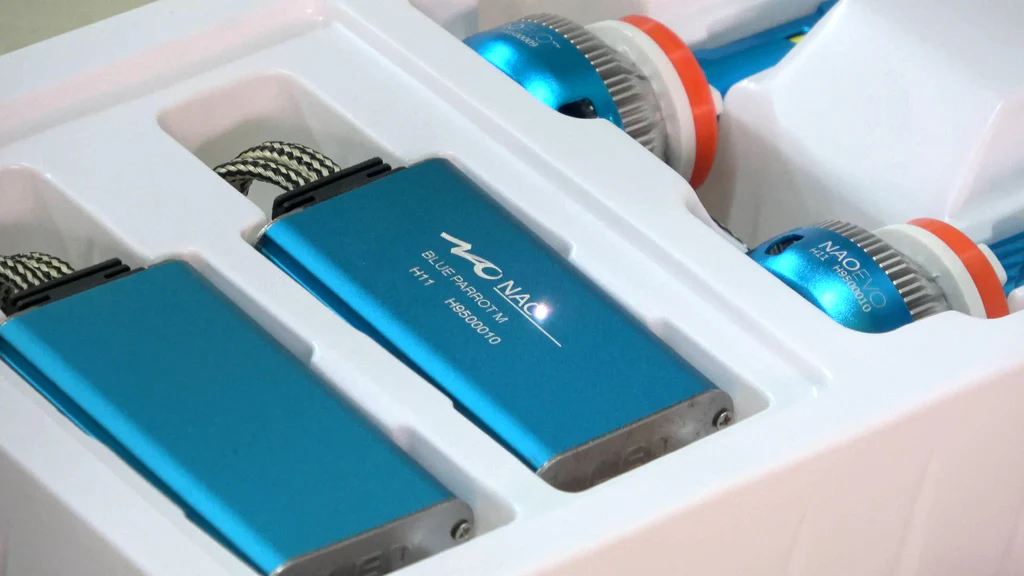
Here we get a semi-finished light bulb, we will print our logo on LED light bulbs with the laser printer. As one of the largest LED headlight bulb manufacturers in China, NAOEVO also offers a free logo customized service. We aim to satisfy all the demands of our customers.
18. Packaging
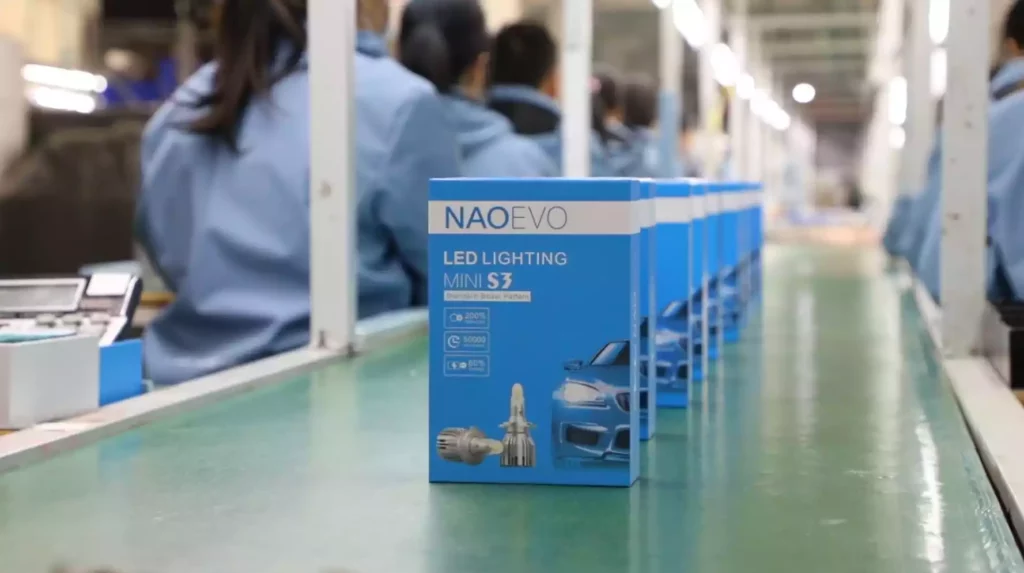
The packaging process for LED headlight bulbs involves carefully placing the bulbs in protective packaging, such as blister packs or boxes, and placing instruction book and product certification.
Why NAOEVO?

Guaranteed Quality
We believe that quality can not be inspected into a product, it must be built into it. All the headlight bulb production processes implement a strict quality management system. From raw material to finished products, we carry out 4 stage inspections:
☑ Raw material inspection
☑ Semi-finished inspection
☑ Finished-product aging inspection
☑ Full inspection before leaving the warehouse
We introduced an advanced machine with skillful workers to ensure “ZERO” defective rate.
Advanced Equipment
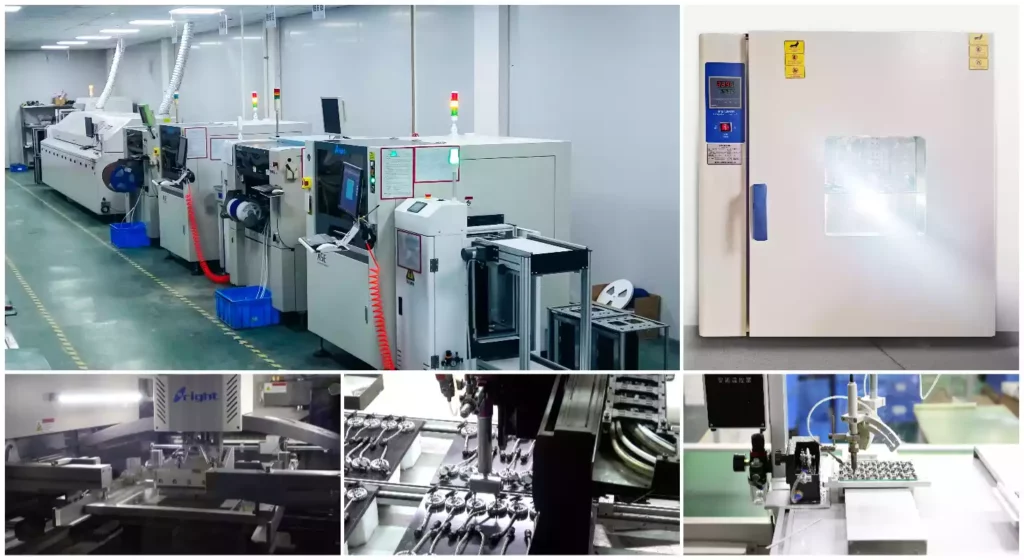
NAOEVO has a wide laboratory and professional equipment. Such as SMT machine, automatic soldering machine, automatic glue dispensing machine, high temperature oven, integrating sphere, and 25-meter car lighting test lab. This results in superior product quality, increased production capacity, shorter lead times, and enhanced customer satisfaction.
Production & Storage capacity
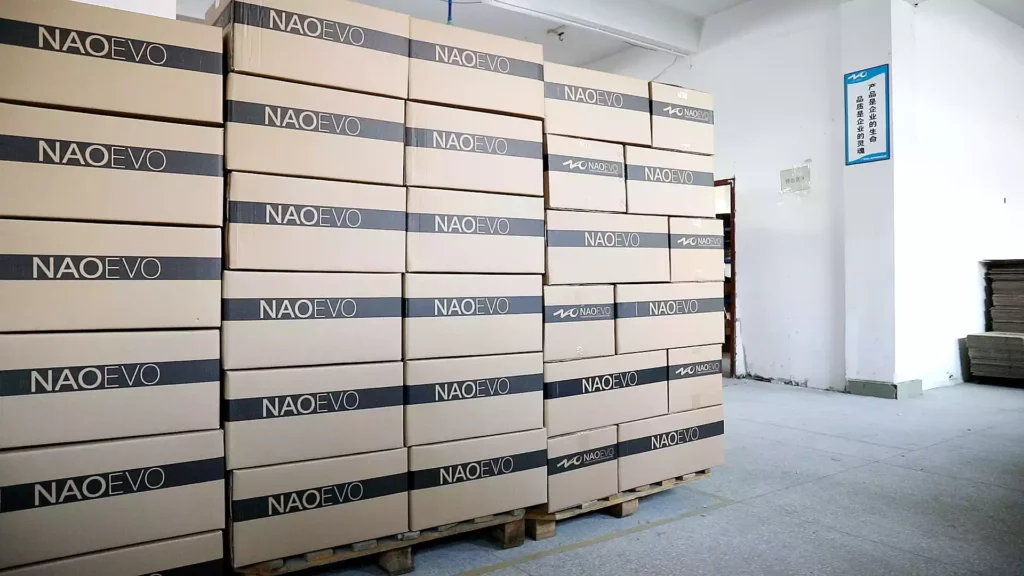
Situated in Baiyun district, our factory spans 10,000 square meters and employs 200 skilled workers along with 20 experienced engineers. With an annual production capacity exceeding 2 million LED headlight kits, we maintain a stock of over 100,000 kits for prompt delivery.
Customized Solution
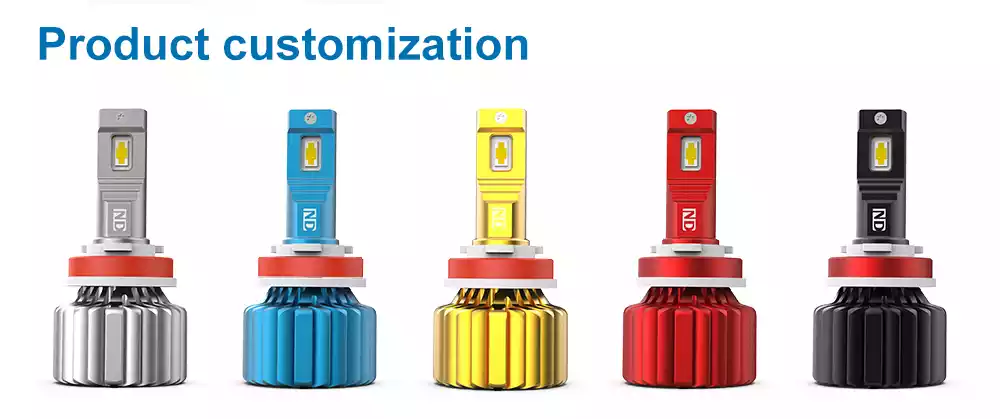
NAOEVO is a renowned manufacturer with an experience design and engineering team. Our dedicated professionals are skilled in providing best-in-class custom services, catering to the different requirements of our clients. We provide OEM
Customization services, including customized logo, packaging, product appearance, LED light color, etc.
Exclusive Supports For Distributor
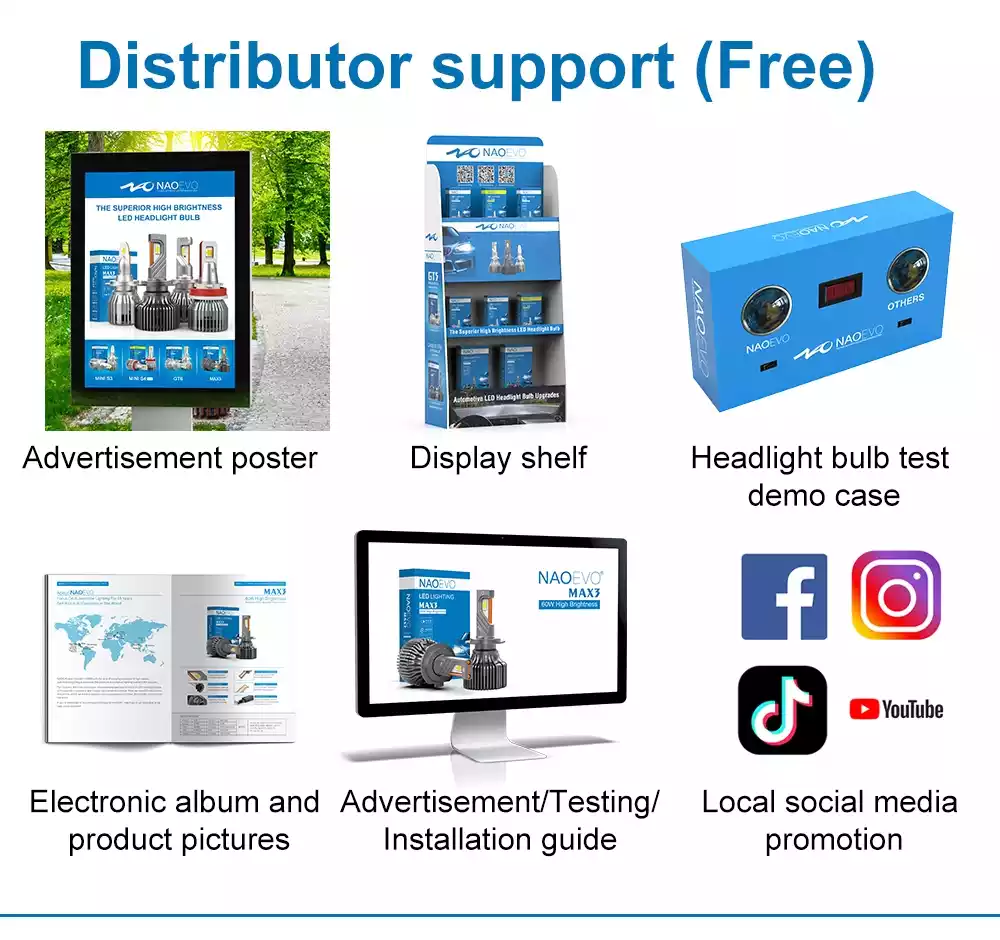
Anyone who becomes the authorised distributor of NAOEVO will enjoy a series of marketing supports, such as priority select for new products, competitive wholesale prices, local market promotion, product catalog & posters, testing box and display racks.
We provide comprehensive marketing materials, strategic guidance, and collaborative campaigns to enhance brand visibility, drive sales, and foster long-term partnerships. Our goal is to empower distributors and ensure their prosperity in the market.

